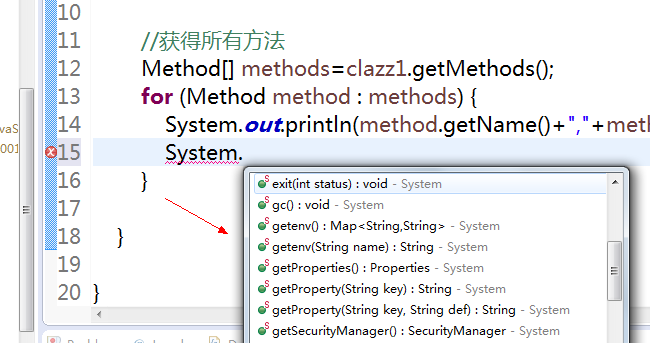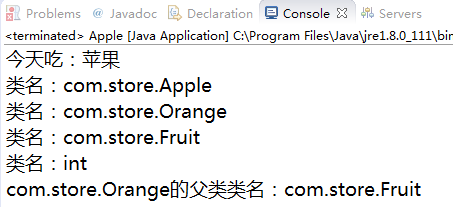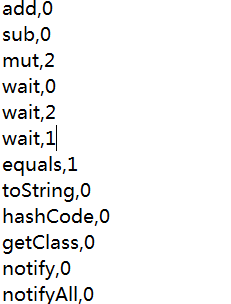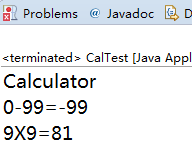一、静态语言与动态语言
静态类型语言:是指在编译时变量的数据类型即可确定的语言,多数静态类型语言要求在使用变量之前必须声明数据类型,某些具有类型推导能力的现代语言可能能够部分减轻这个要求。强类型
动态类型语言:是在运行时确定数据类型的语言。变量使用之前不需要类型声明,通常变量的类型是被赋值的那个值的类型。弱类型
静态:C#,Java,C,C++
动态:JavaScript,python,perl,ruby,php
静态类型语言因为类型强制声明,所以IDE可以做到很好的代码感知能力,因为有IDE的撑腰,所以开发大型系统,复杂系统比较有保障。
静态语言相对比较封闭的特点,使得第三方开发包对代码的侵害性可以降到很低。动态语言在这点上表现的就比较差,我想大家都有过从网上下载某个JS包,然后放到项目代码里发生冲突的经历。
二、反射概要
2.1、概念
反射就是可以在运行时加载类信息,并可以创建其对象访问其属性和方法。这种动态获取的信息以及动态调用对象的方法的功能称为java语言的反射机制。
通俗说:运行时获得并使用类的信息的方法叫反射
2.2、功能

- 在运行时判断任意一个对象所属的类;
- 在运行时构造任意一个类的对象;
- 在运行时判断任意一个类所具有的成员变量和方法;
- 在运行时调用任意一个对象的方法;生成动态代理。
- 动态获得类型信息(方法,字段,属性…)
- 动态时创建对象(根据字符串创建对象)
- 动态调用对象或成员(动态调用方法)
2.3、反射的优点与缺点
优点:
可以实现动态创建对象和编译,体现出很大的灵活性
缺点:
对性能有影响。使用反射基本上是一种解释操作,我们可以告诉JVM,我们希望做什么并且它 满足我们的要求。这类操作总是慢于只直接执行相同的操作。
三、Class
Class 类十分特殊。它和一般类一样继承自Object,其实体用以表达Java程序运行时的classes和interfaces,也用来表达enum、array、primitive Java types(boolean, byte, char, short, int, long, float, double)以及关键词void。当一个class被加载,或当加载器(class loader)的defineClass()被JVM调用,JVM 便自动产生一个Class 对象。因为Class并没有公共的构造方法,只有一个私有的无参构造方法,也就是说 Class 的对象创建只有 JVM 可以完成。
JAVA 使用 Class 对象来执行运行时类型信息(RunTime Type Information,RTTI)。每个类都有一个 Class 对象,它用来创建这个类的所有对象,反过来说,每个类的所有对象都会关联同一个Class 对象(对于数组来说,维数、类型一致的数组的 Class 对象才是相同的),每个对象的创建都依赖于Class 对象的是否创建,Class 对象的创建发生在类加载(java.lang.ClassLoader)的时候。
理解RTTI在Java中的工作原理,首先需要知道类型信息在运行时是如何表示的,这是由Class对象来完成的,它包含了与类有关的信息。Class对象就是用来创建所有“常规”对象的,Java使用Class对象来执行RTTI,即使你正在执行的是类似类型转换这样的操作。
每个类都会产生一个对应的Class对象,也就是保存在.class文件。所有类都是在对其第一次使用时,动态加载到JVM的,当程序创建一个对类的静态成员的引用时,就会加载这个类。Class对象仅在需要的时候才会加载,static初始化是在类加载时进行的。
获得Class对象的办法:
package com.store;
public class Fruit {
public String name;
public static void main(String[] args) throws ClassNotFoundException {
Fruit fruit=new Apple();
System.out.println("今天吃:"+fruit.name);
// public final native java.lang.Class getClass();
//获得Class办法一,通过对象获得
Class clazz1=fruit.getClass();
//获得Class办法二,通过字符串获得(包名+类名)
Class clazz2=Class.forName("com.store.Orange");
//获得Class办法三,(通过类的静态成员class获得)
Class clazz3=Fruit.class;
//获得Class办法四,(只针对内置的基本数据类型)
Class clazz4=Integer.TYPE;
//获得父类类型
Class clazz5=clazz2.getSuperclass();
System.out.println("类名:"+clazz1.getName());
System.out.println("类名:"+clazz2.getName());
System.out.println("类名:"+clazz3.getName());
System.out.println("类名:"+clazz4.getName());
System.out.println("com.store.Orange的父类类名:"+clazz5.getName());
}
}
class Apple extends Fruit{
public Apple() {
this.name="苹果";
}
}
class Orange extends Fruit{
public Orange() {
this.name="橙子";
}
}
输出结果:

四、使用反射
4.1、获得方法信息
定义一个类:
package com.store; /** * 计算器 * */ public class Calculator { public int n1; public int n2; /**加*/ public void add(){ System.out.println(n1+"+"+n2+"="+(n1+n2)); } /**减*/ public void sub(){ System.out.println(n1+"-"+n2+"="+(n1-n2)); } /**乘*/ public int mut(int a,int b){ System.out.println(a+"X"+b+"="+(a*b)); return a*b; } }
获得方法信息:
package com.store; import java.lang.reflect.Method; public class Test { public static void main(String[] args) throws ClassNotFoundException { //获得类型信息 Class clazz1=Class.forName("com.store.Calculator"); //获得所有方法 Method[] methods=clazz1.getMethods(); for (Method method : methods) { System.out.println(method.getName()+","+method.getParameterCount()); } } }
输出结果:

4.2、实例化对象
代码:
package com.store; public class Client { public static void main(String[] args) throws Exception { //根据字符获得Class对象 Class calcClass=Class.forName("com.store.Calculator"); //根据Class对象创建类的实例,调用无参构造方法 Calculator calc=(Calculator)calcClass.newInstance(); //调用方法 calc.add(); } }
结果:

注意:必须要有无参构造方法,如果通过有参构造方法创建对象则必须先获得构造信息
4.3、获得成员变量并赋值
示例:
package com.store; import java.lang.reflect.Field; public class Client { public static void main(String[] args) throws Exception { //根据字符获得Class对象 Class calcClass=Class.forName("com.store.Calculator"); //根据Class对象创建类的实例,调用无参构造方法 Calculator calc=(Calculator)calcClass.newInstance(); //获得成名称为n1的成员变量 Field n1=calcClass.getField("n1"); //赋值,给calc的n1变量赋值 n1.set(calc, 99); //获得成名称为n2的成员变量 Field n2=calcClass.getField("n2"); n2.set(calc,88); //调用方法 calc.add(); } }
结果:

4.4、动态调用方法
示例:
package com.store; import java.lang.reflect.Field; import java.lang.reflect.Method; public class CalTest { public static void main(String[] args) throws Exception { /* Calculator calc=new Calculator(); calc.n1=100; calc.n2=55; calc.add(); */ //获得类型信息 Class<?> calcClazz=Class.forName("com.store.Calculator"); //获得简单名称,没有包名 System.out.println(calcClazz.getSimpleName()); //实例化对象 Calculator calc=(Calculator) calcClazz.newInstance(); //设置字段的值 Field n1=calcClazz.getField("n2"); n1.set(calc, 99); //调用方法 Method m1=calcClazz.getMethod("sub"); m1.invoke(calc); Method m2=calcClazz.getMethod("mut",Integer.TYPE,Integer.TYPE); m2.invoke(calc,9,9); } }
结果:

4.5、动态实例化对象示例
示例:
package com.store; import java.util.Scanner; public class ObjectTest { public static void main(String[] args) throws Exception { Scanner input=new Scanner(System.in); System.out.print("请问您要吃点什么?:"); String type=input.nextLine(); Class<?> clazz=Class.forName("com.store."+type); if(clazz==null){ System.out.println("这个真没有"); }else{ Fruit fruit=(Fruit) clazz.newInstance(); System.out.println("这是您的"+fruit.name+",请慢用。"); } } }
结果:

package com.store; public class Banana extends Fruit{ public Banana() { this.name="香蕉"; } }
这里添加一个Banana类,不需要修改其它代码但增加的功能实现了,满足OCP(对扩展开放对修改关闭)原则。
【案例1】通过一个对象获得完整的包名和类名
package Reflect; /** * 通过一个对象获得完整的包名和类名 * */ class Demo{ //other codes... } class hello{ public static void main(String[] args) { Demo demo=new Demo(); System.out.println(demo.getClass().getName()); } }
【运行结果】:Reflect.Demo
添加一句:所有类的对象其实都是Class的实例。
【案例2】实例化Class类对象
package Reflect; class Demo{ //other codes... } class hello{ public static void main(String[] args) { Class<?> demo1=null; Class<?> demo2=null; Class<?> demo3=null; try{ //一般尽量采用这种形式 demo1=Class.forName("Reflect.Demo"); }catch(Exception e){ e.printStackTrace(); } demo2=new Demo().getClass(); demo3=Demo.class; System.out.println("类名称 "+demo1.getName()); System.out.println("类名称 "+demo2.getName()); System.out.println("类名称 "+demo3.getName()); } }
【运行结果】:
类名称 Reflect.Demo
类名称 Reflect.Demo
类名称 Reflect.Demo
【案例3】通过Class实例化其他类的对象
通过无参构造实例化对象
package Reflect; class Person{ public String getName() { return name; } public void setName(String name) { this.name = name; } public int getAge() { return age; } public void setAge(int age) { this.age = age; } @Override public String toString(){ return "["+this.name+" "+this.age+"]"; } private String name; private int age; } class hello{ public static void main(String[] args) { Class<?> demo=null; try{ demo=Class.forName("Reflect.Person"); }catch (Exception e) { e.printStackTrace(); } Person per=null; try { per=(Person)demo.newInstance(); } catch (InstantiationException e) { // TODO Auto-generated catch block e.printStackTrace(); } catch (IllegalAccessException e) { // TODO Auto-generated catch block e.printStackTrace(); } per.setName("Rollen"); per.setAge(20); System.out.println(per); } }
【运行结果】:
[Rollen 20]
但是注意一下,当我们把Person中的默认的无参构造函数取消的时候,比如自己定义只定义一个有参数的构造函数之后,会出现错误:
比如我定义了一个构造函数
public Person(String name, int age) { this.age=age; this.name=name; }
然后继续运行上面的程序,会出现:
java.lang.InstantiationException: Reflect.Person
at java.lang.Class.newInstance0(Class.java:340)
at java.lang.Class.newInstance(Class.java:308)
at Reflect.hello.main(hello.java:39)
Exception in thread "main" java.lang.NullPointerException
at Reflect.hello.main(hello.java:47)
所以大家以后再编写使用Class实例化其他类的对象的时候,一定要自己定义无参的构造函数
【案例】通过Class调用其他类中的构造函数 (也可以通过这种方式通过Class创建其他类的对象)
package Reflect; import java.lang.reflect.Constructor; class Person{ public Person() { } public Person(String name){ this.name=name; } public Person(int age){ this.age=age; } public Person(String name, int age) { this.age=age; this.name=name; } public String getName() { return name; } public int getAge() { return age; } @Override public String toString(){ return "["+this.name+" "+this.age+"]"; } private String name; private int age; } class hello{ public static void main(String[] args) { Class<?> demo=null; try{ demo=Class.forName("Reflect.Person"); }catch (Exception e) { e.printStackTrace(); } Person per1=null; Person per2=null; Person per3=null; Person per4=null; //取得全部的构造函数 Constructor<?> cons[]=demo.getConstructors(); try{ per1=(Person)cons[0].newInstance(); per2=(Person)cons[1].newInstance("Rollen"); per3=(Person)cons[2].newInstance(20); per4=(Person)cons[3].newInstance("Rollen",20); }catch(Exception e){ e.printStackTrace(); } System.out.println(per1); System.out.println(per2); System.out.println(per3); System.out.println(per4); } }
【运行结果】:
[null 0]
[Rollen 0]
[null 20]
[Rollen 20]
【案例】
返回一个类实现的接口:
package Reflect; interface China{ public static final String name="Rollen"; public static int age=20; public void sayChina(); public void sayHello(String name, int age); } class Person implements China{ public Person() { } public Person(String sex){ this.sex=sex; } public String getSex() { return sex; } public void setSex(String sex) { this.sex = sex; } @Override public void sayChina(){ System.out.println("hello ,china"); } @Override public void sayHello(String name, int age){ System.out.println(name+" "+age); } private String sex; } class hello{ public static void main(String[] args) { Class<?> demo=null; try{ demo=Class.forName("Reflect.Person"); }catch (Exception e) { e.printStackTrace(); } //保存所有的接口 Class<?> intes[]=demo.getInterfaces(); for (int i = 0; i < intes.length; i++) { System.out.println("实现的接口 "+intes[i].getName()); } } }
【运行结果】:
实现的接口 Reflect.China
(注意,以下几个例子,都会用到这个例子的Person类,所以为节省篇幅,此处不再粘贴Person的代码部分,只粘贴主类hello的代码)
【案例】:取得其他类中的父类
class hello{ public static void main(String[] args) { Class<?> demo=null; try{ demo=Class.forName("Reflect.Person"); }catch (Exception e) { e.printStackTrace(); } //取得父类 Class<?> temp=demo.getSuperclass(); System.out.println("继承的父类为: "+temp.getName()); } }
【运行结果】
继承的父类为: java.lang.Object
【案例】:获得其他类中的全部构造函数
这个例子需要在程序开头添加import java.lang.reflect.*;
然后将主类编写为:
class hello{ public static void main(String[] args) { Class<?> demo=null; try{ demo=Class.forName("Reflect.Person"); }catch (Exception e) { e.printStackTrace(); } Constructor<?>cons[]=demo.getConstructors(); for (int i = 0; i < cons.length; i++) { System.out.println("构造方法: "+cons[i]); } } }
【运行结果】:
构造方法: public Reflect.Person()
构造方法: public Reflect.Person(java.lang.String)
但是细心的读者会发现,上面的构造函数没有public 或者private这一类的修饰符
下面这个例子我们就来获取修饰符
class hello{ public static void main(String[] args) { Class<?> demo=null; try{ demo=Class.forName("Reflect.Person"); }catch (Exception e) { e.printStackTrace(); } Constructor<?>cons[]=demo.getConstructors(); for (int i = 0; i < cons.length; i++) { Class<?> p[]=cons[i].getParameterTypes(); System.out.print("构造方法: "); int mo=cons[i].getModifiers(); System.out.print(Modifier.toString(mo)+" "); System.out.print(cons[i].getName()); System.out.print("("); for(int j=0;j<p.length;++j){ System.out.print(p[j].getName()+" arg"+i); if(j<p.length-1){ System.out.print(","); } } System.out.println("){}"); } } }
【运行结果】:
构造方法: public Reflect.Person(){}
构造方法: public Reflect.Person(java.lang.String arg1){}
有时候一个方法可能还有异常,呵呵。下面看看:
class hello{ public static void main(String[] args) { Class<?> demo=null; try{ demo=Class.forName("Reflect.Person"); }catch (Exception e) { e.printStackTrace(); } Method method[]=demo.getMethods(); for(int i=0;i<method.length;++i){ Class<?> returnType=method[i].getReturnType(); Class<?> para[]=method[i].getParameterTypes(); int temp=method[i].getModifiers(); System.out.print(Modifier.toString(temp)+" "); System.out.print(returnType.getName()+" "); System.out.print(method[i].getName()+" "); System.out.print("("); for(int j=0;j<para.length;++j){ System.out.print(para[j].getName()+" "+"arg"+j); if(j<para.length-1){ System.out.print(","); } } Class<?> exce[]=method[i].getExceptionTypes(); if(exce.length>0){ System.out.print(") throws "); for(int k=0;k<exce.length;++k){ System.out.print(exce[k].getName()+" "); if(k<exce.length-1){ System.out.print(","); } } }else{ System.out.print(")"); } System.out.println(); } } }
【运行结果】:
public java.lang.String getSex ()
public void setSex (java.lang.String arg0)
public void sayChina ()
public void sayHello (java.lang.String arg0,int arg1)
public final native void wait (long arg0) throws java.lang.InterruptedException
public final void wait () throws java.lang.InterruptedException
public final void wait (long arg0,int arg1) throws java.lang.InterruptedException
public boolean equals (java.lang.Object arg0)
public java.lang.String toString ()
public native int hashCode ()
public final native java.lang.Class getClass ()
public final native void notify ()
public final native void notifyAll ()
【案例】接下来让我们取得其他类的全部属性吧,最后我讲这些整理在一起,也就是通过class取得一个类的全部框架
class hello { public static void main(String[] args) { Class<?> demo = null; try { demo = Class.forName("Reflect.Person"); } catch (Exception e) { e.printStackTrace(); } System.out.println("===============本类属性========================"); // 取得本类的全部属性 Field[] field = demo.getDeclaredFields(); for (int i = 0; i < field.length; i++) { // 权限修饰符 int mo = field[i].getModifiers(); String priv = Modifier.toString(mo); // 属性类型 Class<?> type = field[i].getType(); System.out.println(priv + " " + type.getName() + " " + field[i].getName() + ";"); } System.out.println("===============实现的接口或者父类的属性========================"); // 取得实现的接口或者父类的属性 Field[] filed1 = demo.getFields(); for (int j = 0; j < filed1.length; j++) { // 权限修饰符 int mo = filed1[j].getModifiers(); String priv = Modifier.toString(mo); // 属性类型 Class<?> type = filed1[j].getType(); System.out.println(priv + " " + type.getName() + " " + filed1[j].getName() + ";"); } } }
【运行结果】:
===============本类属性========================
private java.lang.String sex;
===============实现的接口或者父类的属性========================
public static final java.lang.String name;
public static final int age;
【案例】其实还可以通过反射调用其他类中的方法:
class hello { public static void main(String[] args) { Class<?> demo = null; try { demo = Class.forName("Reflect.Person"); } catch (Exception e) { e.printStackTrace(); } try{ //调用Person类中的sayChina方法 Method method=demo.getMethod("sayChina"); method.invoke(demo.newInstance()); //调用Person的sayHello方法 method=demo.getMethod("sayHello", String.class,int.class); method.invoke(demo.newInstance(),"Rollen",20); }catch (Exception e) { e.printStackTrace(); } } }
【运行结果】:
hello ,china
Rollen 20
【案例】调用其他类的set和get方法
class hello { public static void main(String[] args) { Class<?> demo = null; Object obj=null; try { demo = Class.forName("Reflect.Person"); } catch (Exception e) { e.printStackTrace(); } try{ obj=demo.newInstance(); }catch (Exception e) { e.printStackTrace(); } setter(obj,"Sex","男",String.class); getter(obj,"Sex"); } /** * @param obj * 操作的对象 * @param att * 操作的属性 * */ public static void getter(Object obj, String att) { try { Method method = obj.getClass().getMethod("get" + att); System.out.println(method.invoke(obj)); } catch (Exception e) { e.printStackTrace(); } } /** * @param obj * 操作的对象 * @param att * 操作的属性 * @param value * 设置的值 * @param type * 参数的属性 * */ public static void setter(Object obj, String att, Object value, Class<?> type) { try { Method method = obj.getClass().getMethod("set" + att, type); method.invoke(obj, value); } catch (Exception e) { e.printStackTrace(); } } }// end class
【运行结果】:
男
【案例】通过反射操作属性
class hello { public static void main(String[] args) throws Exception { Class<?> demo = null; Object obj = null; demo = Class.forName("Reflect.Person"); obj = demo.newInstance(); Field field = demo.getDeclaredField("sex"); field.setAccessible(true); field.set(obj, "男"); System.out.println(field.get(obj)); } }// end class
【案例】通过反射取得并修改数组的信息:
import java.lang.reflect.*; class hello{ public static void main(String[] args) { int[] temp={1,2,3,4,5}; Class<?>demo=temp.getClass().getComponentType(); System.out.println("数组类型: "+demo.getName()); System.out.println("数组长度 "+Array.getLength(temp)); System.out.println("数组的第一个元素: "+Array.get(temp, 0)); Array.set(temp, 0, 100); System.out.println("修改之后数组第一个元素为: "+Array.get(temp, 0)); } }
【运行结果】:
数组类型: int
数组长度 5
数组的第一个元素: 1
修改之后数组第一个元素为: 100
【案例】通过反射修改数组大小
class hello{ public static void main(String[] args) { int[] temp={1,2,3,4,5,6,7,8,9}; int[] newTemp=(int[])arrayInc(temp,15); print(newTemp); System.out.println("====================="); String[] atr={"a","b","c"}; String[] str1=(String[])arrayInc(atr,8); print(str1); } /** * 修改数组大小 * */ public static Object arrayInc(Object obj,int len){ Class<?>arr=obj.getClass().getComponentType(); Object newArr=Array.newInstance(arr, len); int co=Array.getLength(obj); System.arraycopy(obj, 0, newArr, 0, co); return newArr; } /** * 打印 * */ public static void print(Object obj){ Class<?>c=obj.getClass(); if(!c.isArray()){ return; } System.out.println("数组长度为: "+Array.getLength(obj)); for (int i = 0; i < Array.getLength(obj); i++) { System.out.print(Array.get(obj, i)+" "); } } }
【运行结果】:
数组长度为: 15
1 2 3 4 5 6 7 8 9 0 0 0 0 0 0 =====================
数组长度为: 8
a b c null null null null null
动态代理
【案例】首先来看看如何获得类加载器:
class test{ } class hello{ public static void main(String[] args) { test t=new test(); System.out.println("类加载器 "+t.getClass().getClassLoader().getClass().getName()); } }
【程序输出】:
类加载器 sun.misc.Launcher$AppClassLoader
其实在java中有三种类类加载器。
1)Bootstrap ClassLoader 此加载器采用c++编写,一般开发中很少见。
2)Extension ClassLoader 用来进行扩展类的加载,一般对应的是jre\lib\ext目录中的类
3)AppClassLoader 加载classpath指定的类,是最常用的加载器。同时也是java中默认的加载器。
如果想要完成动态代理,首先需要定义一个InvocationHandler接口的子类,已完成代理的具体操作。
package Reflect; import java.lang.reflect.*; //定义项目接口 interface Subject { public String say(String name, int age); } // 定义真实项目 class RealSubject implements Subject { @Override public String say(String name, int age) { return name + " " + age; } } class MyInvocationHandler implements InvocationHandler { private Object obj = null; public Object bind(Object obj) { this.obj = obj; return Proxy.newProxyInstance(obj.getClass().getClassLoader(), obj .getClass().getInterfaces(), this); } @Override public Object invoke(Object proxy, Method method, Object[] args) throws Throwable { Object temp = method.invoke(this.obj, args); return temp; } } class hello { public static void main(String[] args) { MyInvocationHandler demo = new MyInvocationHandler(); Subject sub = (Subject) demo.bind(new RealSubject()); String info = sub.say("Rollen", 20); System.out.println(info); } }
【运行结果】:
Rollen 20
类的生命周期
在一个类编译完成之后,下一步就需要开始使用类,如果要使用一个类,肯定离不开JVM。在程序执行中JVM通过装载,链接,初始化这3个步骤完成。
类的装载是通过类加载器完成的,加载器将.class文件的二进制文件装入JVM的方法区,并且在堆区创建描述这个类的java.lang.Class对象。用来封装数据。 但是同一个类只会被类装载器装载以前
链接就是把二进制数据组装为可以运行的状态。
链接分为校验,准备,解析这3个阶段
校验一般用来确认此二进制文件是否适合当前的JVM(版本),
准备就是为静态成员分配内存空间,。并设置默认值
解析指的是转换常量池中的代码作为直接引用的过程,直到所有的符号引用都可以被运行程序使用(建立完整的对应关系)
完成之后,类型也就完成了初始化,初始化之后类的对象就可以正常使用了,直到一个对象不再使用之后,将被垃圾回收。释放空间。
当没有任何引用指向Class对象时就会被卸载,结束类的生命周期
将反射用于工厂模式
先来看看,如果不用反射的时候,的工厂模式吧:
http://www.cnblogs.com/rollenholt/archive/2011/08/18/2144851.html
/** * @author Rollen-Holt 设计模式之 工厂模式 */ interface fruit{ public abstract void eat(); } class Apple implements fruit{ public void eat(){ System.out.println("Apple"); } } class Orange implements fruit{ public void eat(){ System.out.println("Orange"); } } // 构造工厂类 // 也就是说以后如果我们在添加其他的实例的时候只需要修改工厂类就行了 class Factory{ public static fruit getInstance(String fruitName){ fruit f=null; if("Apple".equals(fruitName)){ f=new Apple(); } if("Orange".equals(fruitName)){ f=new Orange(); } return f; } } class hello{ public static void main(String[] a){ fruit f=Factory.getInstance("Orange"); f.eat(); } }
这样,当我们在添加一个子类的时候,就需要修改工厂类了。如果我们添加太多的子类的时候,改的就会很多。
现在我们看看利用反射机制:
package Reflect; interface fruit{ public abstract void eat(); } class Apple implements fruit{ public void eat(){ System.out.println("Apple"); } } class Orange implements fruit{ public void eat(){ System.out.println("Orange"); } } class Factory{ public static fruit getInstance(String ClassName){ fruit f=null; try{ f=(fruit)Class.forName(ClassName).newInstance(); }catch (Exception e) { e.printStackTrace(); } return f; } } class hello{ public static void main(String[] a){ fruit f=Factory.getInstance("Reflect.Apple"); if(f!=null){ f.eat(); } } }
现在就算我们添加任意多个子类的时候,工厂类就不需要修改。
上面的爱吗虽然可以通过反射取得接口的实例,但是需要传入完整的包和类名。而且用户也无法知道一个接口有多少个可以使用的子类,所以我们通过属性文件的形式配置所需要的子类。
下面我们来看看: 结合属性文件的工厂模式
首先创建一个fruit.properties的资源文件,
内容为:
apple=Reflect.Apple
orange=Reflect.Orange
然后编写主类代码:
package Reflect; import java.io.*; import java.util.*; interface fruit{ public abstract void eat(); } class Apple implements fruit{ public void eat(){ System.out.println("Apple"); } } class Orange implements fruit{ public void eat(){ System.out.println("Orange"); } } //操作属性文件类 class init{ public static Properties getPro() throws FileNotFoundException, IOException{ Properties pro=new Properties(); File f=new File("fruit.properties"); if(f.exists()){ pro.load(new FileInputStream(f)); }else{ pro.setProperty("apple", "Reflect.Apple"); pro.setProperty("orange", "Reflect.Orange"); pro.store(new FileOutputStream(f), "FRUIT CLASS"); } return pro; } } class Factory{ public static fruit getInstance(String ClassName){ fruit f=null; try{ f=(fruit)Class.forName(ClassName).newInstance(); }catch (Exception e) { e.printStackTrace(); } return f; } } class hello{ public static void main(String[] a) throws FileNotFoundException, IOException{ Properties pro=init.getPro(); fruit f=Factory.getInstance(pro.getProperty("apple")); if(f!=null){ f.eat(); } } }